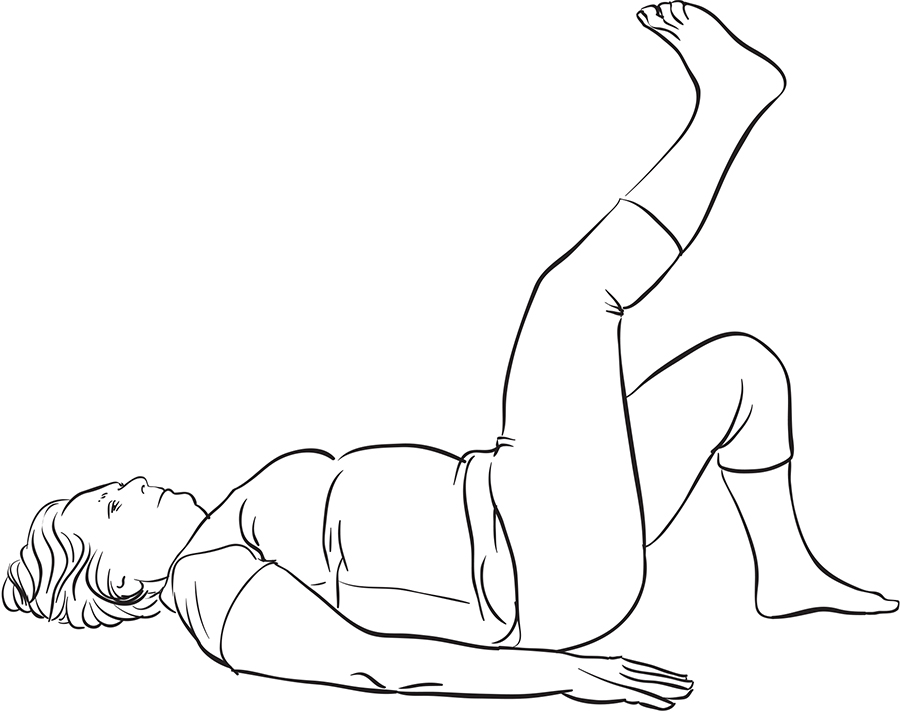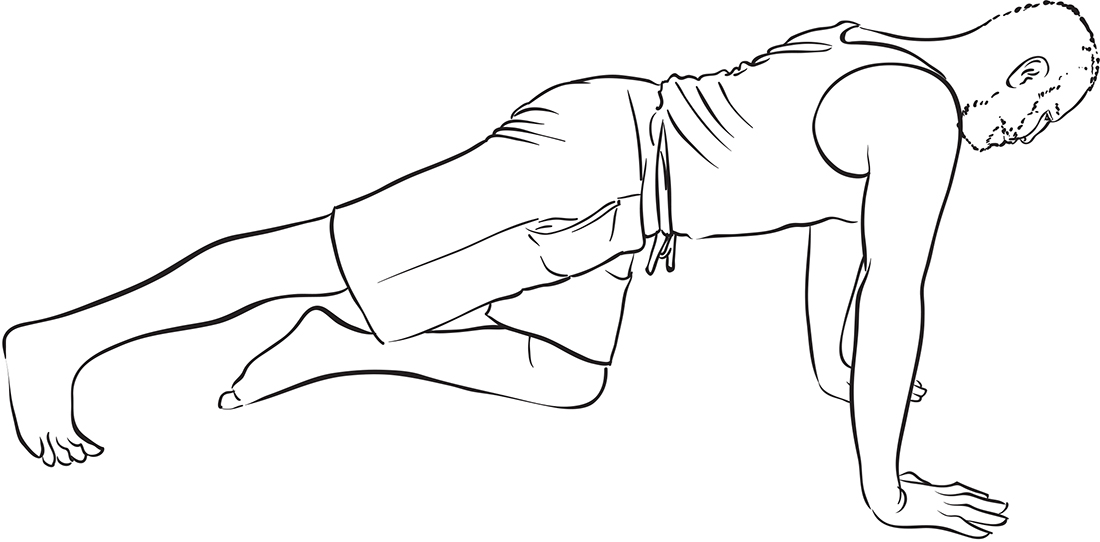Chapter 10
Week 6: Core Strengthening to Enhance Spinal Health
Discovering strength in our center, in our core, is desirable for various reasons. Metaphorically, feeling strong and steady in our center helps us stay focused and connected to our inner resources. Physically, feeling strong in our core helps maintain spinal and functional health. Balanced core strength includes more than sit-ups, which tend to mostly strengthen the superficial abdominal muscles. True core strength focuses on the deeper layers of abdominal muscles in the front of the belly and the sides of the torso, as well as the muscles that support the spine and pelvis. The practices introduced in this chapter are designed to help you build strength in your core to enliven your center.
Practicing the art of welcoming whatever arises, even if it’s something difficult—such as a physical or emotional pain—can be essential to finding freedom from suffering.
Functional Benefits of the Core-Strengthening Practice
Relieves back pain. A strong core provides a healthy foundation for all the body’s movements and is a key component in relieving back pain.
Builds strength required for daily activities. Maintaining core strength allows us to continue participating in many of our daily activities, such as tying our shoes, dressing, housecleaning, and cooking.
Expands the potential for recreation. Many of our recreational pleasures—golfing, gardening, tennis, and physical intimacy—are all supported by good core strength.
As a reminder, you can download audio for week 6’s practice at http://www.newharbinger.com/33643 .
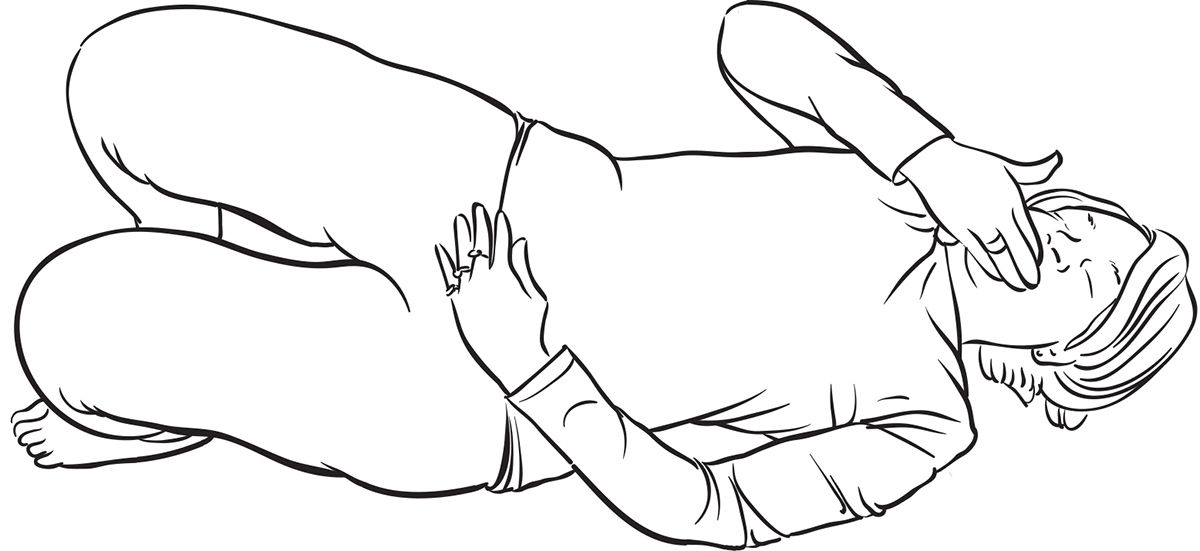
Figure 10.1 Royal Cough pose
Setup
Lie on your back with your knees bent, feet flat on the ground, and arms at your sides. If your chin is higher than your forehead, place a folded blanket or towel behind your head so that your chin is at the same level or slightly below your forehead. Tune in to your breath.
Movement
- Place one hand on your lower belly and the other over your mouth, then cough (see figure 10.1).
- Notice how your abdominal muscles engage and your belly bounces when you cough.
- Now, practice engaging the muscles that are activated when you cough, but without actually coughing. Explore this action without interfering with your breath.
- Next, relax your abdominals completely as you inhale, feeling your belly round, just as you do in Three-Part Breath.
- This time, as you exhale, engage your abdominals and draw your belly in toward your spine. Practice this pattern several times: relaxed abdominal muscles on an inhalation, engaged abdominal muscles on an exhalation.
Remember
- • Notice how your body feels when your abdominals are engaged and when they are not.
- • Try to draw in your abdominal muscles without compromising your breath.
Setup
Lie on your back with your knees bent, feet flat on the ground and hip-width apart. Position your head so that your neck maintains its natural curve. Place your arms along your sides, palms down. Tune in to your breath.
Movement
- Lift your right foot off the ground and bring your right knee in toward your belly (see figure 10.2).
- Inhale and extend your right leg up toward the sky, flexing your ankle (see figure 10.3).
- Exhale and engage the deep belly muscles of the Royal Cough (see page 168) as you lower your leg until it is just above the ground (see figure 10.4).
- Inhale and bend your right knee, bringing it back in toward your belly, then extend your right leg back up toward the sky.
- Exhale and lower your leg until it is just above the ground, engaging the strength in your center.
- Repeat a couple of times at your own pace.
- To build more strength, linger with your right leg hovering just above the ground for a couple of breaths. Be sure to keep your breath flowing comfortably.
- When you are ready, exhale your leg to the ground and notice the cascade of release when gravity takes over and your leg can rest. Pause here to be present for this letting go.
- Repeat on the other side.
- When you are done, place both feet on the ground, knees bent, and enjoy several smooth breaths.
- • Engage only the muscles that you need, softening what you don’t need. Be sure to keep your upper body—shoulders, neck, and face—relaxed.
- • Find ease in your breath. If you need more than one breath to extend your leg or bend your knee, that’s fine. Just do your best and avoid holding your breath.
Caution
- • Be sure to bend your knee toward your belly before extending your leg straight up. Avoid lifting a straight leg up from the ground.
- • If your low back feels strained, try rooting your low back into the ground by engaging your belly throughout the movement.

Figure 10.5 Lake Mudra pose
Setup
Lie on your back with your knees bent, feet flat on the ground about hip-width apart. Extend your arms down by your sides with your palms facing your thighs. Tune in to your breath.
Movement
- Inhale and extend your left arm up and back toward your ear as you extend your right leg out, hovering a few inches above the ground (see figure 10.5).
- Exhale and return your arm and leg to the starting position.
- Inhale and extend your right arm and left leg, lengthening across the diagonal.
- Exhale and return to the starting position.
- Continue with this movement, inhaling to extend your opposite limbs across the diagonal and exhaling to return to the starting position.
- Engage your lower belly, drawing it in toward your spine to stabilize your pelvis.
- For more challenge, explore pausing in the extended position. Keep your breath fluid. Practice engaging the strength in your center.
- Play with this practice for several breaths, challenging your core. When you are ready to rest, bring your arms back along your sides, bend your knees, and bring the soles of your feet to the ground. Pause here and notice how you feel.
Remember
- • If your low back feels strained, emphasize drawing your lower belly strongly to the spine and rooting your low back into the ground throughout the movement. You may also slide your leg out along the ground, letting it touch down instead of hovering above the ground.
- • Remain curious as to how your body, mind, and heart are responding to the experience.
Setup
Come onto your hands and knees on a mat or soft carpet. In this tabletop position, place your hands under your shoulders and your knees under your hips. Feel free to cushion your wrists and/or your knees with a folded towel or other prop. Tune in to your breath.
Movement
- Root down into your hands. Feel a sense of aliveness in your arms and chest. Be sure to keep length in your spine, with the top of your head extending forward and your tailbone extending back.
- Draw your belly toward your spine using the action of the Royal Cough (see page 168).
- Extend your right leg back and tuck your toes under so they rest on the ground (see figure 10.6).
- On an inhalation, lift your right leg up with your foot flexed, keeping the front of your knee and the tips of your toes pointing directly toward the ground (see figure 10.7).
- Keep your breath flowing as you continue to extend your leg back, as if your heel could touch the wall behind you. Be sure that the front of your right hip is parallel to the ground.
- To add more challenge, crawl the fingers of your left hand forward, then float your left arm up (see figure 10.8).
- Rotate the palm of your left hand so that your thumb is pointing toward the sky.
- Maintain strength and awareness in your belly to support your extended limbs by hugging the belly to the spine.
- Lengthen across the diagonal of your body, extending from the fingertips of your left hand to the heel of your right foot.
- After a few breaths, return your hand and knee to the ground.
- Relax your head and let your tailbone be heavy.
- Breathe into your back.
- Repeat on the other side.
- When you are finished, feel free to rest for several breaths in Child’s pose.
- • Let your breath be easy.
- • If your knees are uncomfortable, try placing a pillow or rolled towel under them.
- • If this position is too demanding for your wrists, try coming down onto your forearms, or make fists and balance on your knuckles. Sometimes a little cushion under the heels of your hands (such as a folded washcloth) can help.
Caution
- • Avoid pushing into your hands too strongly—be sure not to round your back when you root down into your hands.

Figure 10.9
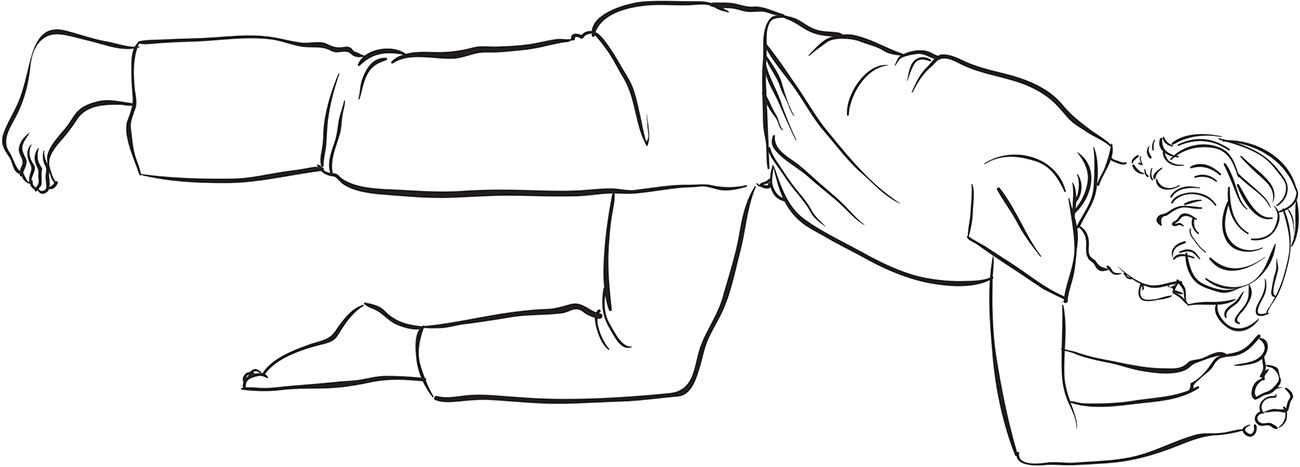
Figure 10.10
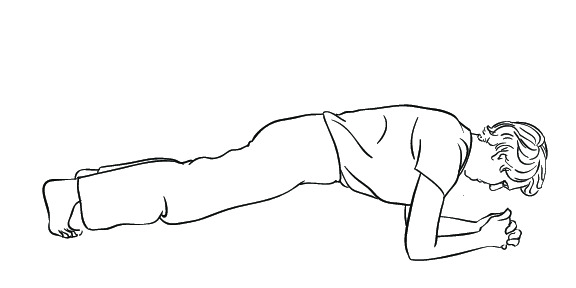
Figure 10.11
Come onto your hands and knees on a mat or soft carpet. Lower your forearms to the ground, with your elbows under your shoulders. Interlace your fingers and create a tripod of support. Tune in to your breath.
Movement
- Engage the muscles of your lower belly using the action of the Royal Cough (see page 168).
- Draw your shoulders back and down.
- Root your forearms into the ground to engage your arms and chest.
- Step your right leg back, toes tucked under so they rest on the mat or carpet (see figure 10.9).
- Balance your weight between your right and left arms.
- Explore lifting your right leg up to the height of your hip, toes and knee facing down (see figure 10.10).
- Take a few easy breaths, then return your right knee to the ground.
- Step your left leg back, toes tucked under, and balance the weight evenly between both arms.
- Explore lifting your left leg up to the height of your hip, toes and knee facing down.
- Breathe here until you are ready to return your left knee to the ground.
- To increase the challenge, explore stepping both legs back with the toes tucked under (see figure 10.11).
- Extend your tailbone toward your heels, root into the ground with your forearms, and engage the muscles of your belly.
- Maintain ease in your breath.
- When you are done, release your knees to the ground and stretch your back by bringing your hips toward your heels in Child’s pose.
Remember
- • Keep your breath flowing smoothly.
- • Move through the variations as you feel ready. There is no rush. Strength will build over time.

